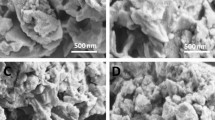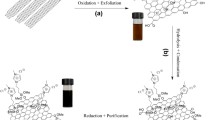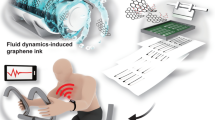Abstract
Owing to the great demand for portable and wearable chemical sensors, the development of all-solid-state potentiometric ion sensors is highly desirable considering their simplicity and stability. However, most ion sensors are challenged by the penetration of water and gas molecules into ion-selective membranes, causing unstable and undesirable sensing performances. In this study, a hydrophobic ionic liquid-modified graphene (Gr) sheet was prepared using a fluid dynamics-induced exfoliation and functionalization process. The high hydrophobicity and electrical double-layer capacitance of Gr make it a potential solid-state ion-to-electron transducer for the development of potentiometric sodium-ion (Na+) sensors. The as-prepared Na+ sensors effectively prevented the formation of the water layer and penetration of gas species, resulting in stable and high sensing performances. The Na+ sensors showed a Nernstian sensitivity of 58.11 mV/[Na+] with a low relative standard deviation (0.46), fast response time (5.1 s), good selectivity (K < 10−4), and good durability. Furthermore, the Na+ sensor demonstrated its feasibility in practical applications by measuring accurate and reliable ion concentrations of artificial human sweat and tear samples, comparable to a commercial ion meter.





Similar content being viewed by others
Availability of data and materials
The datasets used and/or analyzed during the current study are available from the corresponding author on reasonable request.
References
Parrilla M, Cuartero M, Sánchez SP, Rajabi M, Roxhed N, Niklaus F, Crespo GA (2019) Wearable all-solid-state potentiometric microneedle patch for intradermal potassium detection. Anal Chem 91:1578–1586. https://doi.org/10.1021/acs.analchem.8b04877
Abisegapriyan KS, Alluri NR, Sharma K, Maria Joseph Raj NP, Kim S (2022) A mechano-driven multi-ion sensor based on piezo-ionophoretic coupling for real time perspiration monitoring. Appl Mater Today 29:101679. https://doi.org/10.1016/j.apmt.2022.101679
Nakata S, Shiomi M, Fujita Y, Arie T, Akita S, Takei K (2018) A wearable pH sensor with high sensitivity based on a flexible charge-coupled device. Nat Electron 1:596–603. https://doi.org/10.1038/s41928-018-0162-5
Gao F, Liu C, Zhang L, Liu T, Wang Z, Song Z, Cai H, Fang Z, Chen J, Wang J, Han M, Wang J, Lin K, Wang R, Li M, Mei Q, Ma X, Liang S, Gou G, Xue N (2023) Wearable and flexible electrochemical sensors for sweat analysis: a review. Microsyst Nanoeng 9:1. https://doi.org/10.1038/s41378-022-00443-6
Chandran N, Janardhanan P, Bayal M, Pilankatta R, Nair SS (2022) Development of a paper printed colorimetric sensor based on Cu-Curcumin nanoparticles for evolving point-of-care clinical diagnosis of sodium. Sci Rep 12:6247. https://doi.org/10.1038/s41598-022-09852-z
Zdrachek E, Bakker E (2019) Potentiometric sensing. Anal Chem 91:2–26. https://doi.org/10.1021/acs.analchem.8b04681
Ding J, Qin W (2020) Recent advances in potentiometric biosensors. Trends Anal Chem 124:115803. https://doi.org/10.1016/j.trac.2019.115803
Choi D, Li Y, Cutting GR, Searson PC (2017) A wearable potentiometric sensor with integrated salt bridge for sweat chloride measurement. Sens Actuators B Chem 250:673–678. https://doi.org/10.1016/j.snb.2017.04.129
Wang S, Wu Y, Gu Y, Li T, Luo H, Li L, Bai Y, Li L, Liu L, Cao Y, Ding H, Zhang T (2017) Wearable sweatband sensor platform based on gold nanodendrite array as efficient solid contact of ion-selective electrode. Anal Chem 89:10224–10231. https://doi.org/10.1021/acs.analchem.7b01560
Shao Y, Ying Y, Ping J (2020) Recent advances in solid-contact ion-selective electrodes: functional materials, transduction mechanisms, and development trends. Chem Soc Rev 49:4405–4465. https://doi.org/10.1039/C9CS00587K
Cuartero M, Crespo GA (2018) All-solid-state potentiometric sensors: a new wave for in situ aquatic research. Curr Opin Eletrochem 10:98–106. https://doi.org/10.1016/j.coelec.2018.04.004
An Q, Gan S, Xu J, Bao Y, Wu T, Kong H, Zhong L, Ma Y, Song Z, Niu L (2019) A multichannel electrochemical all-solid-state wearable potentiometric sensor for real-time sweat ion monitoring. Electrochem Commun 107:106553. https://doi.org/10.1016/j.elecom.2019.106553
Park HJ, Jeong J, Yoon JH, Son SG, Kim YK, Kim DH, Lee KG, Choi BG (2020) Preparation of ultrathin defect-free graphene sheets from graphite via fluidic delamination for solid-contact ion-to-electron transducers in potentiometric sensors. J Colloid Interface Sci 560:817–824. https://doi.org/10.1016/j.jcis.2019.11.001
Zhang D, Yang Z, Li P, Pang M, Xue Q (2019) Flexible self-powered high-performance ammonia sensor based on Au decorated MoSe2 nanoflowers driven by single layer MoS2-flake piezoelectric nanogenerator. Nano Energy 65:103974. https://doi.org/10.1016/j.nanoen.2019.103974
Hu J, Stein A, Bühlmann P (2016) Rational design of all-solid-state ion-selective electrodes and reference electrodes. Trends Anal Chem 76:102–114. https://doi.org/10.1016/j.trac.2015.11.004
Boeva ZA, Lindfors T (2016) Few-layer graphene and polyaniline composite as ion-to-electron transducer in silicone rubber solid-contact ion-selective electrodes. Sens Actuators B Chem 224:624–631. https://doi.org/10.1016/j.snb.2015.10.054
Mendecki L, Mirica KA (2018) Conductive metal−organic frameworks as ion-to-electron transducers in potentiometric sensors. ACS Appl Mater Interfaces 10:19248–19257. https://doi.org/10.1021/acsami.8b03956
Rousseau CR, Bühlmann P (2021) Calibration-free potentiometric sensing with solid-contact ion-selective electrodes. Trends Anal Chem 140:116277. https://doi.org/10.1016/j.trac.2021.116277
Han T, Mattinen U, Bobacka J (2019) Improving the sensitivity of solid-contact ion-selective electrodes by using coulometric signal transduction. ACS Sens 4:900–906. https://doi.org/10.1021/acssensors.8b01649
Liu H, Li Q, Zhang S, Yin R, Liu X, He Y, Dai K, Shan C, Guo J, Liu C, Shen C, Wang X, Wang N, Wang Z, Wei R, Guo Z (2018) Electrically conductive polymer composites for smart flexible strain sensors: a critical review. J Mater Chem 6:12121. https://doi.org/10.1039/C8TC04079F
Naveen MH, Gurudatt NG, Shim Y (2017) Applications of conducting polymer composites to electrochemical sensors: a review. Appl Mater Today 9:419–433. https://doi.org/10.1016/j.apmt.2017.09.001
Kil MS, Park HJ, Yoon JH, Jang J, Lee KG, Choi BG (2022) Stretchable graphene conductor based on fuid dynamics and its application to fexible conductometric sensor. Carbon Lett 32:1791–1798. https://doi.org/10.1007/s42823-022-00403-0
Jiang C, Yao Y, Cai Y, Ping J (2019) All-solid-state potentiometric sensor using single-walled carbon nanohorns as transducer. Sens Actuators B Chem 283:284–289. https://doi.org/10.1016/j.snb.2018.12.040
Arduini F, Cinti S, Mazzaracchio V, Scognamiglio V, Amine A, Moscone D (2022) Carbon black as an outstanding and affordable nanomaterial for electrochemical (bio)sensor design. Biosens Bioelectron 156:112033. https://doi.org/10.1016/j.bios.2020.112033
Nag A, Mitra A, Mukhopadhyay SC (2017) Graphene and its sensor-based applications: a review. Sens Actuator A Phys 270:177–194. https://doi.org/10.1016/j.sna.2017.12.028
Vicentini FC, Ravanini AE, Figueiredo-Filho LCS, Iniesta J, Banks CE, Fatibello-Filho O (2015) Imparting improvements in electrochemical sensors: evaluation of different carbon blacks that give rise to significant improvement in the performance of electroanalytical sensing platforms. Electrochim Acta 157:125–133. https://doi.org/10.1016/j.electacta.2014.11.204
Koskun Y, Şavk A, Şen B, Şen F (2018) Highly sensitive glucose sensor based on monodisperse palladium nickel/activated carbon nanocomposites. Anal Chim Acta 1010:37–43. https://doi.org/10.1016/j.aca.2018.01.035
Schroeder V, Savagatrup S, He M, Lin S, Swager TM (2019) Carbon nanotube chemical sensors. Chem Rev 119:599–663. https://doi.org/10.1021/acs.chemrev.8b00340
Liu Y, Liu Y, Yan R, Gao Y, Wang P (2020) Bimetallic AuCu nanoparticles coupled with multi-walled carbon nanotubes as ion-to-electron transducers in solid-contact potentiometric sensors. Electrochim Acta 331:135370. https://doi.org/10.1016/j.electacta.2019.135370
Krishnan SK, Singh E, Singh P, Meyyappan M, Nalwa HS (2019) A review on graphene-based nanocomposites for electrochemical and fluorescent biosensors. RSC Adv 9:8778–8881. https://doi.org/10.1039/C8RA09577A
Thuy NTD, Zhao G, Wang X, Awuah E, Zhang L (2022) potassium ion-selective electrode with a sensitive ion-to-electron transducer composed of porous laser-induced graphene and MoS2 fabricated by one-step direct laser writing. Electroanalysis 34:1–14. https://doi.org/10.1002/elan.202200194
Papageorgiou DG, Kinloch IA, Young RJ (2017) Mechanical properties of graphene and graphene-based nanocomposites. Prog Mater Sci 90:75–127. https://doi.org/10.1016/j.pmatsci.2017.07.004
Tiwari SK, Sahoo S, Wang N, Huczko A (2020) Graphene research and their outputs: status and prospect. J Sci Adv Mater Devices 5:10–29. https://doi.org/10.1016/j.jsamd.2020.01.006
Liu Y, Liu Y, Meng Z, Qin Y, Jiang D, Xi K, Wang P (2020) Thiol-functionalized reduced graphene oxide as self-assembled ion-to-electron transducer for durable solid-contact ion-selective electrodes. Talanta 208:120374. https://doi.org/10.1016/j.talanta.2019.120374
Li J, Qin W (2020) An integrated all-solid-state screen-printed potentiometric sensor based on a three-dimensional self-assembled graphene aerogel. Microchem J 159:105453. https://doi.org/10.1016/j.microc.2020.105453
Park HJ, Jeong J, Son SG, Kin SJ, Lee M, Kim HJ, Jeong J, Hwang SY, Park J, Eom Y, Choi BG (2021) Fluid-dynamics-processed highly stretchable, conductive, and printable graphene inks for real-time monitoring sweat during stretching exercise. Adv Funct Mater 31:2011059. https://doi.org/10.1002/adfm.202011059
Jeong J, Jin SB, Park HJ, Park SH, Jeon H, Suh H, Park Y, Seo D, Hwang SY, Kim DH, Choi BG (2020) Large-scale fast fluid dynamic processes for the syntheses of 2D nanohybrids of metal nanoparticle-deposited boron nitride nanosheet and their glycolysis of poly(ethylene terephthalate). Adv Mater Interfaces 7:2000599. https://doi.org/10.1002/admi.202000599
Son SG, Park HJ, Kim S, Kim SJ, Kil MS, Jeong J, Lee Y, Eom Y, Hwang SY, Park J, Choi BG (2023) Ultra-fast self-healable stretchable bio-based elastomer/graphene ink using fluid dynamics process for printed wearable sweat-monitoring sensor. Chem Eng J 454:140443. https://doi.org/10.1016/j.cej.2022.140443
Jeong J, Kang HG, Kim H, Hong SB, Jeon H, Hwang SY, Seo D, Kwak BE, Han Y, Choi BG, Kim DH (2018) Hydraulic power manufacturing for highly scalable and stable 2D nanosheet dispersions and their film electrode application. Adv Funct Mater 28:1802952. https://doi.org/10.1002/adfm.201802952
Song Y, Min J, Gao W (2019) Wearable and implantable electronics: moving toward precision therapy. ACS Nano 13:12280–12286. https://doi.org/10.1021/acsnano.9b08323
Yoon JH, Park HJ, Park SH, Lee KG, Choi BG (2020) Electrochemical characterization of reduced graphene oxide as an ion-to-electron transducer and application of screen-printed all-solid-state potassium ion sensors. Carbon Lett 30:73–80. https://doi.org/10.1007/s42823-019-00072-6
Yoon JH, Kim S, Eom Y, Koo JM, Cho H, Lee TJ, Lee KG, Park HJ, Kim YK, Yoo H, Hwang SY, Park J, Choi BG (2019) Extremely fast self-healable bio-based supramolecular polymer for wearable real-time sweat-monitoring sensor. ACS Appl Mater Interfaces 11:46165–46175. https://doi.org/10.1021/acsami.9b16829
Kim SJ, Kil MS, Park HJ, Yoon JH, Kim J, Bae NH, Lee KG, Choi BG (2022) Highly stretchable and conductive carbon thread incorporated into elastic rubber for wearable real-time monitoring of sweat during stretching exercise. Adv Mater Technol. https://doi.org/10.1002/admt.202201042
Kim DS, Jeong J, Park HJ, Kim YK, Lee KG, Choi BG (2021) Highly concentrated, conductive, defect-free graphene ink for screen-printed sensor application. Nano-Micro Lett 13:87. https://doi.org/10.1007/s40820-021-00617-3
Buck RP, Lindner E (1994) Recommendations for nomenclature of ionselective electrodes (IUPAC Recommendations 1994). Pure Appl Chem 66:2527–2536. https://doi.org/10.1351/pac199466122527
Pingarrón JM, Labuda J, Barek J, Brett CMA, Camões MF, Fojta M, Hibbert DB (2020) Terminology of electrochemical methods of analysis (IUPAC Recommendations 2019). Pure Appl Chem 92:641–694. https://doi.org/10.1515/pac-2018-0109
Maccà C (2004) Response time of ion-selective electrodes current usage versus IUPAC recommendations. Anal Chim Acta 512:183–190. https://doi.org/10.1016/j.aca.2004.03.010
Bakker E, Pretsch E, Bühlmann P (2000) Selectivity of potentiometric ion sensors. Anal Chem 72:1127–1133. https://doi.org/10.1021/ac991146n
Acknowledgements
This work was supported by the National Research Foundation of Korea (NRF) Grant funded by the Ministry of Science and ICT (No. 2021R1A2C1009926); the Technology Innovation Program (or Industrial Strategic Technology Development Program) (20015577) funded by the Ministry of Trade, Industry & Energy (MOTIE, Korea); and the Nanomedical Devices Development Project of NNFC in 2023.
Author information
Authors and Affiliations
Corresponding author
Ethics declarations
Conflict of interest
The authors declare that they have no competing interests.
Additional information
Publisher's Note
Springer Nature remains neutral with regard to jurisdictional claims in published maps and institutional affiliations.
Rights and permissions
Springer Nature or its licensor (e.g. a society or other partner) holds exclusive rights to this article under a publishing agreement with the author(s) or other rightsholder(s); author self-archiving of the accepted manuscript version of this article is solely governed by the terms of such publishing agreement and applicable law.
About this article
Cite this article
Yoon, E.S., Park, H.J., Yoon, J.H. et al. Hydrophobic ionic liquid-modified graphene via fluid-dynamic process for ion-to-electron transducers for all-solid-state potentiometric sensors. Carbon Lett. 33, 1561–1569 (2023). https://doi.org/10.1007/s42823-023-00521-3
Received:
Revised:
Accepted:
Published:
Issue Date:
DOI: https://doi.org/10.1007/s42823-023-00521-3




